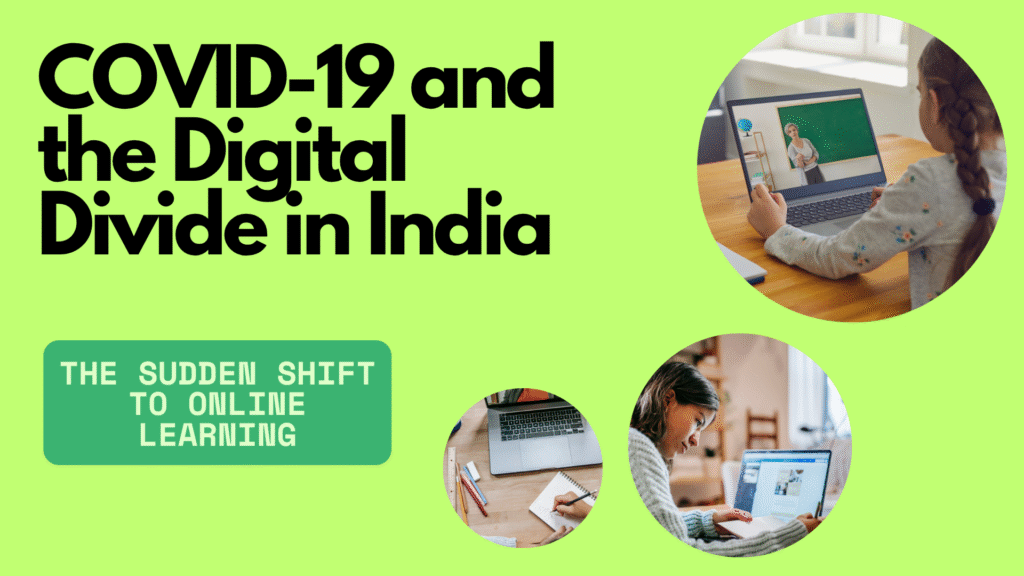COVID-19 and the Digital Divide in India is not just about technology—it’s about inequality, opportunity, and the future of our youth.
Table of Contents
Introduction
I still remember March 2020 vividly. The world around me changed overnight. One day I was walking to the local market and the next, everything moved online—work, education, even catching up with friends. At first, I was amazed at how seamlessly some parts of our lives transitioned. But soon, I started noticing cracks—especially in education. Not everyone could join this digital revolution. Some students I knew didn’t have a laptop, others struggled with a weak internet connection, and a few didn’t know how to navigate online classes at all. That’s when it truly hit me:
This article explores how the pandemic exposed the deep digital divide in India, especially in higher education. I’ll share what I saw, learned, and believe we need to do to create a more inclusive educational system.
Examining the Inequity in Students’ Experiences with COVID-19 and Digital Learning in Indian Higher Education
The Sudden Shift to Online Learning
When lockdowns began, higher education institutions across India scrambled to transition online. At first, I was impressed. Classes continued, assignments were submitted, and webinars replaced physical seminars. But the excitement didn’t last long. I quickly realized that while some students adapted easily, others struggled enormously.
For continuity and safety, online education became the only choice. Colleges adopted platforms like Zoom, Google Meet, and even WhatsApp to deliver education. But this exposed huge differences in students’ ability to participate effectively.
The Unveiling of the Digital Divide
Access to Devices: I recall hearing about a friend’s cousin who had to borrow his neighbor’s phone every day to attend lectures. Some students didn’t own laptops; others shared one device among multiple siblings.
Internet Connectivity: For many, slow internet wasn’t just annoying—it meant missing lectures entirely. I remember a rural student who said she had to climb onto the roof of her house to get even a weak signal.
Digital Literacy: Having a smartphone isn’t enough. Some professors and students lacked the skills necessary to use online platforms efficiently. Navigating a Google Classroom or turning in a PDF assignment was unfamiliar territory for many.
The result? Unequal learning outcomes. Students with better access thrived. Others lagged behind, not because they lacked intelligence, but because they lacked resources. This digital divide turned into an educational divide.
Digital Education‘s Advantages Over the Pandemic’s Effect on Indian Higher Education
Despite the challenges, I must admit—digital education did offer some unexpected benefits.
Increased Accessibility
For students living in remote areas or with physical disabilities, online education was a blessing. I heard from a student with a mobility issue who finally felt included in college activities, thanks to digital access.
Flexibility and Autonomy
Recorded lectures allowed students to learn at their own pace. I personally found this helpful. I could watch a live lesson again if I missed something. It gave students more control over their learning.
Rich Learning Resources
COVID-19 and the Digital Divide in India Online gives a platforms to students access to YouTube tutorials, digital libraries, and MOOCs (Massive Open Online Courses). Education expanded globally and was no longer confined to textbooks.
Digital Skill Development
Even students who were initially uncomfortable with technology eventually picked up essential digital skills. This kind of digital fluency will be invaluable in the future job market. and it helps COVID-19 and the Digital Divide in India to make great future

Higher Education’s Digital Transformation: How Instructor Training Affects Class Effectiveness During COVID-19
The Role of Educators
We often talk about students, but I want to take a moment to appreciate our educators. Many of them were forced to switch from chalkboards to screens almost overnight. It wasn’t easy.
Challenges Faced by Teachers
- No Training: Many teachers were not trained in online pedagogy. Navigating a video conferencing tool or engaging students through a screen was completely new.
- Tech Troubles: I remember one professor struggling to share his screen during an important lecture. Technical issues frustrated both students and teachers.
- Maintaining Engagement: It’s hard to gauge if students are listening or zoning out. Teachers had to learn new ways to keep classes interactive.
Power of Training
Where training programs were implemented, I saw a clear improvement. Instructors became more confident, used digital tools effectively, and kept students engaged through quizzes, breakout rooms, and interactive content.
Training not only improved class delivery but also boosted morale. When educators feel equipped, they teach better. Additionally, pupils learn better when teachers are more effective.
Conclusion: Lessons Learned and the Path Forward
From where I stand, COVID-19 and the Digital Divide in India taught us one undeniable lesson: technology can empower—but only if everyone has equal access.
Key Takeaways
We’ve seen how access to devices, internet, and digital literacy significantly impacted student success. But we also witnessed how digital learning brought flexibility, inclusivity, and innovation when used effectively.
What Needs to Change?
- Bridge the Access Gap: Government and institutions must ensure every student has access to affordable devices and reliable internet.
- Invest in Digital Literacy: It’s not enough to hand out gadgets—we must teach people how to use them effectively.
- Train Educators Continuously: Professional development for teachers must be ongoing, not reactive.
- Promote Hybrid Learning Models: A mix of online and offline methods could offer the best of both worlds.
- Collaborate Across Sectors: Private companies, NGOs, and government must work together to build a digitally inclusive education system.
Final Thought
The pandemic was a wake-up call. It showed us where we shine and where we fall short. But it also gave us a blueprint for the future. A truly inclusive India must be digitally inclusive. We have the tools—now we need the will.